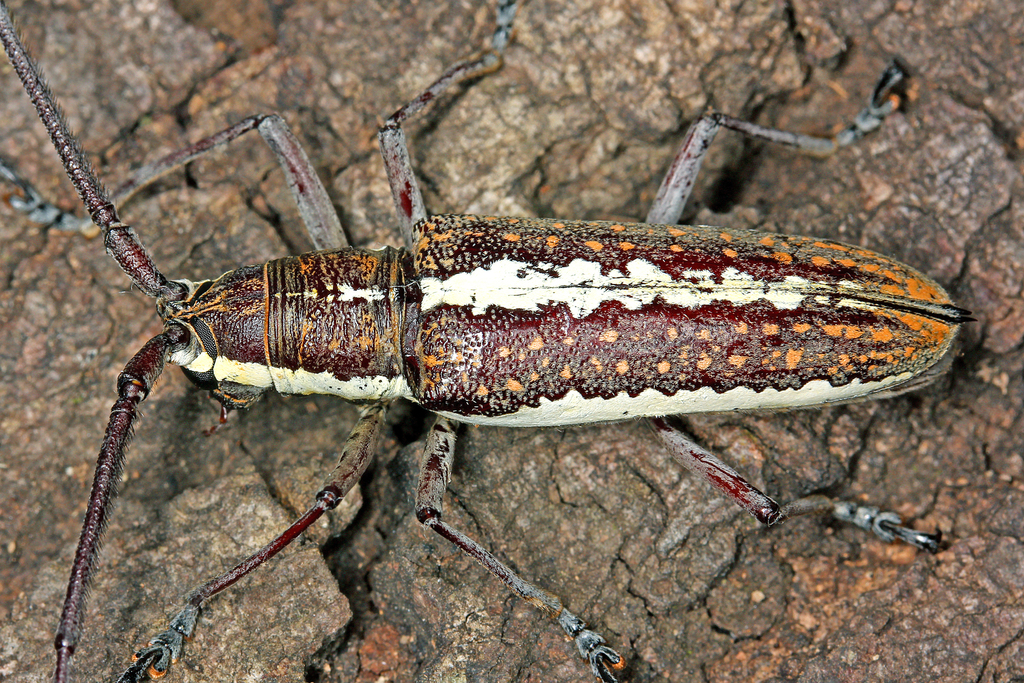Troublemaking Duo: Fig Borers & Fig Souring
Published 1:52 pm Tuesday, July 8, 2025

- The three-lined fig borer (Ptychodes trilineatus or Neoptychodes trilineatus), is a beetle which bores into wood and primarily attacks fig trees within in the southern US with a range that extends from Texas to Florida (image: inaturalist.org).
|
Getting your Trinity Audio player ready...
|
A couple weeks ago we discussed various types of fig trees which perform well in our climate and provide gardeners with a considerable amount of fruit. Our wonderful SETX weather conditions this year have been perfect, setting the stage for a bountiful fig harvest. Hopefully, each of you are experiencing the same, as the fig trees located in our backyard are producing an overabundance of figs this year, much more than years past. While harvesting figs in the late evening while the wind is calm, a faint aroma was detected…distinct and familiar. The scent is pungent though softly pleasant, and reminiscent of days passed when I would ferment grapes and other fruits into wine. A pleasant memory… though a bit concerning at this moment as we were harvesting figs. Literally, the perimeter of one fig tree smelled of fermentation and there were several limbs which were diseased, dead, or dying.
Fig trees are susceptible to insect infestation and damage which is often caused by fig borers. Fig borers are primarily beetles. The beetles lay eggs beneath the bark of fig trees, and when the larvae hatch, they penetrate a limb, then further bore into the wood and cause damage to the tree. Two of the most common types of fig tree borers located in the US are the three-lined fig tree borer (Ptychodes trilineatus) and the long-horned beetle fig and willow borer (Phryneta spinator).
- Three-lined fig tree borer (Neoptychodes trilineatus) is a common fig borer found in Southern US and Central America. The adult beetle is large, mainly black with three white stripes. The larvae initially bore into branches then the trunk, feeding on the wood for months to a year causing extensive damage.
- Longhorn beetle borers (Phryneta spinator) feed on the bark and rind of figs. The larvae bore into the wood of various host trees, as well as figs themselves.
Fig trees are often attracted to stressed or weakened trees. Maintaining a healthy fig tree through proper watering, fertilization, and pruning can help prevent infestations. If infestation occurs, prompt detection and removal of affected parts is necessary. Early detection and control are crucial to prevent significant damage.
Trending
Identification
Frass- has a “sawdust-like” appearance and will be located at the base of the tree or entry holes
Bark Holes- small entry/ exit holes in the trunk and branches
Leaf Wilt- infestation will cause leaves to wilt, branches to die as larvae disrupt the tree’s vascular system
Loose bark- damaged bark that appears loose and cracked
Visible Larvae– infected branches may reveal larvae or pupae once cut open
Trending
Prevention
Maintain healthy trees with proper watering, fertilization, and pruning to make them less susceptible to attack. Remove and destroy infested branches, especially those with visible larvae or frass, to prevent further spread. Do not compost infected materials, place them into plastic garbage bags and tighten securely, then deposit in waste receptacle. An alternative is to dispose of pruned branches and infested wood by burning to prevent further spread.
Control
There are occasions when infestations are so severe that insecticides like chlorpyrifos, lambda-cyhalothrin, carbaryl, permethrin, or imidacloprid may need to be used. Gardeners need to follow directions provided by the chemical manufacturer. However, these chemicals are often only effective against young larvae. Please note that using more than required is damaging to our environment and pollinators.
Fig souring (aka fig sour rot) can become problematic rendering all the fruits on a fig tree inedible. Souring is caused by several different types of yeast and bacteria and almost always spread by vectors (insects). Fortunately, effective management is easy!
Fig souring symptoms are easily recognizable…as the figs begin to ripen, they will emit a ‘fermented’ scent and a clear, viscous fluid will weep from the bottom-center (eye) often forming bubbles. When temperatures are elevated, the flesh inside the fruit liquifies, forming a white froth, then the fruit will become limp, turning black before shriveling either dropping from the tree or remaining there until dislodged.
While not a disease, fig souring can be the result of any number of bacteria, fungi, and yeast which enter the fig essentially rotting it from within. These pathogens enter the fig through the ostiole (eye) which opens as the fruit ripens allowing insects and other organisms entry. Common culprits for souring are the Nitidulid beetles and fruit flies (which I also noticed are my fig tree). Note that once fig souring has occurred that the affected fruit cannot be saved and should not be consumed.
Fig Souring Causes
Bacteria/ Yeast– enter the fruit through the ‘eye’, cracks and splits which lead to fermentation
Overripe fruit– are most susceptible to entry by bacteria and yeast
Vectors- insects such as beetles and ants can damage the fruit creating entry points
Rain/ Humidity– conditions which can dramatically increase and contribute to fig souring
Air circulation– inadequate airflow will exacerbate the issue of souring fruit
Prevention/ Treatment
Promptly harvest- pick figs often and as soon as they ripen- avoid overripening of fruit
Minimize vectors- utilize netting or organic control (insecticides) to shield figs from insects
Air circulation- improve airflow by pruning the tree to increase airflow
Watering technique- avoid overhead watering, keep fruit dry to reduce the risk of souring
Remove figs- detach and discard soured figs to prevent bacteria/ yeast from spreading
So long for now, fellow gardeners! Let’s go out and grow ourselves a greener, more sustainable world, one plant at a time! Gardening questions answered: jongreene57@gmail.com.





